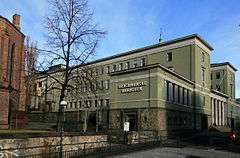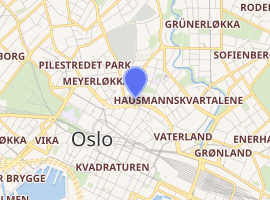Oslo Public Library
Oslo Public Library (officially called in Norwegian Deichmanske bibliotek, Deichman Library), is the municipal public library serving Oslo, Norway and is the country's first and largest library. It employs over 300 people and has over 20 branches throughout the city. Registered users may use the library every day, even when it is not staffed, from 7am to 11pm. It is also possible to borrow and return books when the library is not staffed. One of the most prized books in the library's collection is the Vulgate bible of Aslak Bolt (1430–1450), Norway's only preserved liturgical handwritten manuscript from medieval times. The book itself is estimated to have been written around 1250. The head of the library from 2014 to 2016 was Kristin Danielsen.
| Deichman Library | |
|---|---|
 | |

| |
| General information | |
| Type | Public Library |
| Architectural style | current: Neoclassical planned: Functionalism and Deconstructivism |
| Location | Oslo, Norway |
| Completed | current: 1933 planned:2020 (Expected) |
| Opened | current: 1933 |
| Technical details | |
| Structural system | planned: 3 see-through cubes in light grey/white with openings on the left and right sides on the two other ones. |
| Design and construction | |
| Architect | current: Nils Reiersen planned: Lund Hagem Arkitekter AS og Atelier Oslo arkikteker AS |
| Main contractor | Diagonale |
| Website | |
| www | |
History
The library opened on 12 January 1785, following an endowment from Carl Deichman who also bequeathed 7,000 books and 150 manuscripts which formed the basis of the library's collection.[1]
From the start the library was open to all citizens. At the time most lending libraries charged a membership fee, making it impossible for poorer people to access them. However, the initial collection was largely made up of texts in German, French, Latin and Danish and was therefore largely only of interest to members of the educated upper class. In 1802 it was decided to move the library to the Oslo Cathedral School and to merge it with the school's collection. Jacob Rosted was both librarian of the Deichman Library and rector of the school. The library remained part of the school until the mid 1800s, when it got its own premises. Under the leadership of Haakon Nyhuus, who was head librarian from 1898-1913, the library became a model for public libraries throughout the Nordic region. Nyhuus modernised the library along American lines, having spent eight years in America and been inspired by Carnegie libraries. Among his innovations were the introduction of reading rooms and the addition of books for children and young people. During Nyhuus' time as librarian, the collection tripled in size and the borrowing of books increased by 25 times. The library had an estimated 4000 visitors a day. The library now has a bust of Nyhuus.
Departments
The library has several specialised departments, such as a music department, and a department for children and youth (decorated by Tulla Blomberg Ranslet), a department for prison libraries and a library for patients at the Rikshospital. It previously also housed The Multilingual Library, which is now part of the National Library of Norway.
Building
The library's neoclassical main building is in the St. Hanshaugen district of Oslo. It was designed by Nils Reiersen,[2][3] was completed in 1933. It is often referred to in Norwegian as trappehuset (~"the house of stairs") since it has many staircases. The building houses a bust of Karen-Christine Friele. In 2011 the building was damaged in the bombing of the government quarter. Part of the entrance had to be demolished and all departments in the building were closed to the public for two months after the explosion.
Future location
A new building is being constructed at Bjørvika, next to the Opera and the new Munch Museum, part of the Fjord City renewal project.[4] Lund Hagem Arkitekter AS won the competition to design the new Deichman Library.[5] The building is scheduled to open to the public in 2020. When completed, the new building will hold manuscripts contributed to the Future Library project, among them texts by Margaret Atwood and David Mitchell. Since the new library will have less space than the old one, an estimated 300,000 items belonging to the collection must either be thrown out, sold, transferred to other libraries or given away. The new library will have four times as much space which is accessible to the public. (Around 100,000 square metres.)
External links
References
- John Ansteinsson, "The Library History of Norway", The Library Journal 45 (1920) 19-24, 57-62, p. 22.
- Arne Arnesen, "The Deichman Library in Oslo," Scandinavian Review 20 (1932) p. 428.
- Nils Olaf Reiersen (1878-1950) at arc! 2009, accessed March 15, 2010: "Reiersens viktigste arbeid er utvilsomt hovedbygningen for det Deichmanske Bibliotek på Hammersborg i Oslo (1922-33, monumental nyklassisisme, østfløyen er tilføyet i 1973)." - "Reiersen's most important work is undoubtedly the main building of the Deichman Library at Hammersborg in Oslo (1922-33, monumental neoclassicism, the east wing was added in 1973)."
- "Welcome to Deichmanske bibliotek / Oslo Public Library" (in Norwegian). Oslo Public Library. Retrieved 19 December 2009.
- Deichman Library Competition Winner, archiCentral, May 4, 2009, accessed March 15, 2010.